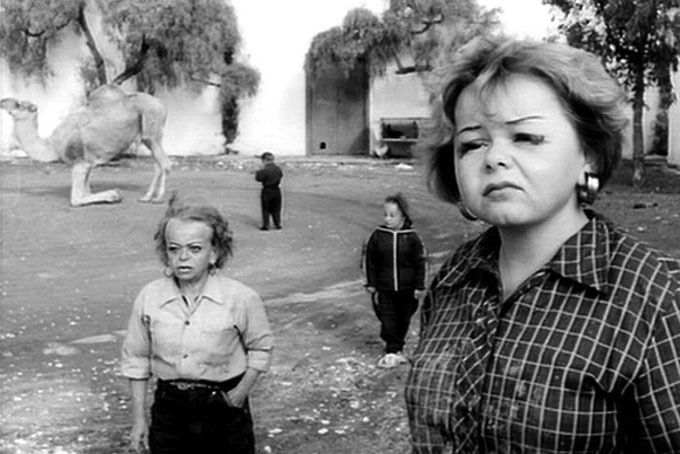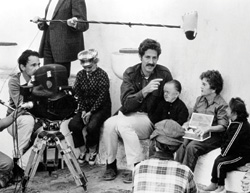HERZOG'S SHORT FEATURE A TALL, TWISTED TALE
 Saturday, April 21, 2012 at 4:25PM
Saturday, April 21, 2012 at 4:25PM Thirty-five years since it premiered, the German auteur's most challenging work continues to cause debate.

Filmed in 1968 by 26 year-old Werner Herzog, Even Dwarfs Started Small remained unreleased for two years. Over that period, rumours circulated as to the nature of Herzog’s bizarre project – was it a political allegory, borne out of the decade’s anti-establishment movement? A statement condemning the futility of counter-culture angst? Or, as many feared, an exploitative ‘freak-show’, masquerading as intellectualism?
By the time it premiered at Cannes in May 1970, the German auteur was prepared for the criticism – having shot an all-dwarf cast and utilised an impenetrably abstract narrative to tell the story of a patient revolt within a mental-health sanitarium, the opinions of the world’s film community must not have seemed particularly daunting. To this day, its merits and worthiness are hotly-debated (in his column dated September 17, 1970, The New York Times’ Vincent Canby called it “meaningless” and the work of a “perverse, uninvolved intelligence”; more recently, Box Office Magazine’s Wade Major said, “Truly one of the most bizarre and hilariously disturbing freakshows ever executed by a major director.”)
 In his homeland, the nihilistic bleakness was too much for many critics who denounced the film, stating any work that suggests a futility in revolutionary fervour must be the work of a fascist sympathiser. In Paul Cronin’s 2003 book, Herzog on Herzog, the director counters with, “I told these agitators that the film had absolutely nothing to do with the 1968 movements, that they were blinded by zealousness.” The film was banned in Germany for being “anarchistic and blasphemous”, according to Herzog; it is often compared to Tod Browning’s 1932 circus-sideshow melodrama, Freaks, which utilised real-life sufferers of profound physical deformities and which also found no favour upon release (Herzog considers Browning’s landmark work "one of the greatest films ever made.")
In his homeland, the nihilistic bleakness was too much for many critics who denounced the film, stating any work that suggests a futility in revolutionary fervour must be the work of a fascist sympathiser. In Paul Cronin’s 2003 book, Herzog on Herzog, the director counters with, “I told these agitators that the film had absolutely nothing to do with the 1968 movements, that they were blinded by zealousness.” The film was banned in Germany for being “anarchistic and blasphemous”, according to Herzog; it is often compared to Tod Browning’s 1932 circus-sideshow melodrama, Freaks, which utilised real-life sufferers of profound physical deformities and which also found no favour upon release (Herzog considers Browning’s landmark work "one of the greatest films ever made.")
Herzog conceived and wrote the story after a vivid dream he had whilst touring Africa; his vision was of an island uprising, led by the smallest dwarf against the rulers of the tribe. Herzog had suffered through an arduous shoot for the documentary The Flying Doctors of East Africa and struggled to capture exteriors for his feature Fata Morgana; upon arriving in the Canary Islands to commence production of Even Dwarfs Started Small, he was already a spent force. “I was full of bitterness, affected by sickness,” Herzog recalls, ”and the film became a more radical film than I had originally planned.”
Of the many aspects of the film that appear ‘radical’ to modern audiences, the unsympathetic portrayal of dwarves will be the most confronting. Having been victimised during their incarceration at the hospital, their revolt and subsequent freedom is fuelled by rage – at the Director of the institution and the tools he has used to contain them; at Mother Nature’s cruelty (other creations of nature, such as animals and plants, become the targets of their rampage); and, finally, at each other. Their anarchy descends into self-destruction and madness - blind dwarves are taunted and attacked; female inmates are coerced into a forced sex act; one dwarf tumbles from the roof of a moving vehicle; a group cackle through the mock crucifixion of a monkey. "Dreams and nightmares do not follow the rules of political correctness," says Herzog.
Adhering to the merest of narrative conventions (the film is framed as a flashback, but that is about as linear as the storytelling gets), much speculation has arisen as to the meaning of the increasingly sad series of disturbing images that comprise Herzog’s film. In a detailed dissection of Even Dwarfs Started Small on the Cinemania website, one scholar flippantly describes the film’s visual style as that of a “Ringling Brothers-on-bad-acid production of Lord Of The Flies” and grandly states, “This is a nightmare from the depths of the unconscious, a too-vivid vision...complete with absurdist normalcy based on the sheer recurring presence of otherwise freakishness (sic).” Counter claims by some analysts suggest the film is structured as and reflective of absurdist comedy; that comparisons to the dark-hearted classics of Kafka and Beckett often ignore the fact that their most famous works (respectively, Metamorphosis and Waiting for Godot) were comedies. Herzog himself may be hinting towards that interpretation with his now-famous final image – the film’s central character, Hombre (Helmut Döring), erupting into a fit of maniacal laughter, then coughing uncontrollably, then laughing some more, as a lame camel defecates.
Most importantly, one feels compelled to ask whether Herzog exploited the dwarf actors in any way. "The dwarves in the film are not freaks, but well proportioned, charming, and beautiful people," Herzog states, speaking specifically to his use and portrayal of their physicality. But author David Church, in his 2005 study ‘Examining the Role of Disability in Herzog's Even Dwarves Started Small’ suggests that exploitation takes many forms. “Filmmakers who use disability as a metaphor are not actually portraying the lives of disabled people; the film was not made for a short-statured audience,” opines Church. “The common use of disabled bodies as a vehicle for speaking specifically to the concerns of an able-bodied audience serves to deny the individual concerns and struggles of persons with disabilities.”

Reader Comments